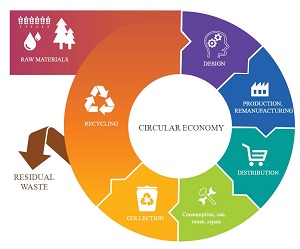The European Union produces more than 2.5 billion tonnes of waste every year. Currently, the amendments of the regulation on waste management amendments of the regulation on waste management are under way to promote the shift towards the circular economy.
The circular economy is a model of production and consumption, which involves sharing, leasing, reusing, repairing, refurbishing and recycling existing materials and products as long as possible to create an additional value of products – i.e. extending the life cycle of products.
By extending the life cycle of products, the quantity of waste is reduced. In comparison, the linear economic model where the products are discarded after use, requires large quantities of cheap materials and energy. (Planned obsolescence is also part of this model.) A circular economy can help mitigate the two key problems – limited resources and climate change.

In March 2020, the European Commission, as part of the Green Deal and in accordance with a New EU industrial strategy it presented the new Circular Economy Action Plan, which includes the proposals on a more sustainable product design, reducing waste, and empowering the citizens (by introducing the “right to repair”). Special focus is put on the resource-intensive sectors, such as electronics and ITC technologies, plastics, textile, and construction.
In 2021, the Parliament voted on the New Circular Economy Action Plan and asked for the additional measures for achieving the carbon-neutral, nontoxic and completely circular economy until 2050, including the stricter rules on recycling, and binding targets for the use and consumption of materials by 2030.
Key the circular economy sectors
The circular economy is a model of production and consumption, which involves sharing, leasing, reusing, repairing, refurbishing and recycling existing materials and products as long as possible to create an additional value of products – i.e. extending the life cycle of products.
By extending the life cycle of products, the quantity of waste is reduced. In comparison, the linear economic model where the products are discarded after use, requires large quantities of cheap materials and energy. (Planned obsolescence is also part of this model.) A circular economy can help mitigate the two key problems – limited resources and climate change.
In March 2020, the European Commission, as part of the Green Deal and in accordance with a New EU industrial strategy it presented the new Circular Economy Action Plan, which includes the proposals on a more sustainable product design, reducing waste, and empowering the citizens (by introducing the “right to repair”). Special focus is put on the resource-intensive sectors, such as electronics and ITC technologies, plastics, textile, and construction.
In 2021, the Parliament voted on the New Circular Economy Action Plan and asked for the additional measures for achieving the carbon-neutral, nontoxic and completely circular economy until 2050, including the stricter rules on recycling, and binding targets for the use and consumption of materials by 2030.
Key the circular economy sectors
- plastics
- textile
- e-waste
- water and food
- packaging
- batteries vehicles, buildings and construction





